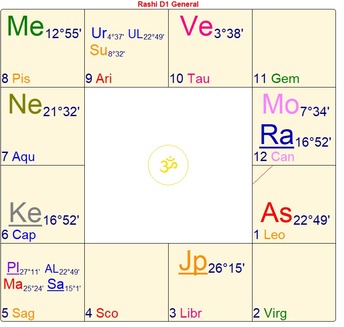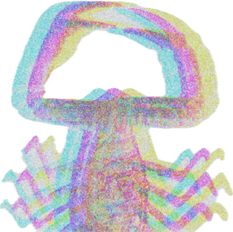When the lunar nodes, Rahu and Ketu, return to their original placement in a birth chart, there is a new karmic path undertaken which takes time to become evident through experience.
Each return of a planet shows a new cycle in relation to what that planet represents. So, for example, the well-known Saturn return - around 27 to 31, 56 to 60 and 84 to 90 – brings maturity at different stages of life, as this is what Saturn represents.
In relation to the nodes, however, there are complexities involved due to their karmic influence which operates, for the large part, outside of our conscious awareness. This is the obscuring nature of eclipses.
In this case, it is helpful to observe the position of the nodes’ dispositors (the planets that rule the sign the nodes are placed in) once the nodes return to their original placement in the horoscope. So, when observing the influence of Rahu and Ketu, one must look to see the sign they are placed in - solar and lunar signs - to ascertain the influence of their rulers.
Rahu represents the impulse to create new karma, i.e. to experience more, while Ketu represents the impulse to finish old karma, i.e. to experience less.
This is true in the natal placement of the nodes or by their transit. When the nodes return to their placement in any given chart, the planet which rules that sign must be looked at with a fresh lens: its placement at the time of the return offers insights into a broad stroke view of the upcoming cycle of the nodes - for the following 18 years.
The example chart I have given is the American chart for the Declaration of Independence, which has been rectified by Vedic astrologer James Kelleher to 18.30 on July 4, 1776 in Philadelphia. I have used this example because this chart recently experienced a nodal return. To make the nodes’ influence even stronger all we have do is to add a 'planetary cycle' of one of the nodes into the mix.
America is currently experiencing a period of Rahu, which began in 2015 and lasts until 2033, so Rahu is representative of the zeitgeist of the country.
This brings issues of divisiveness and upheaval, of revolution and change: Rahu sits in the 8th house. Rahu rules the 3rd house (Aquarius) of confidence.
'Make America Great Again' is a cry from its leader to bring back some sense of power it feels it is losing due to the 8th house being strongly activated – through Rahu’s natal placement, current cycle and its recent return. The nodes returned to their natal position in Cancer/Capricorn in April/May 2018; the position they were placed during the signing of the Declaration of Independence in 1776.
The first obvious pattern is a link between the Moon and Saturn. Rahu in Pushya is associated with Saturn, within the Moon’s sign, Cancer, while Ketu is placed in Sravana, which is associated with the Moon, in Saturn’s sign, Capricorn.
Using the mean calculation, the nodes returned on April 22, 2018: Rahu returned to the exact degree it was placed, in Pushya, and Ketu returned to its exact degree in Sravana. The mean node return is interesting, as the Moon is placed in Cancer for the return chart, further highlighting the 8th house.
Each return of a planet shows a new cycle in relation to what that planet represents. So, for example, the well-known Saturn return - around 27 to 31, 56 to 60 and 84 to 90 – brings maturity at different stages of life, as this is what Saturn represents.
In relation to the nodes, however, there are complexities involved due to their karmic influence which operates, for the large part, outside of our conscious awareness. This is the obscuring nature of eclipses.
In this case, it is helpful to observe the position of the nodes’ dispositors (the planets that rule the sign the nodes are placed in) once the nodes return to their original placement in the horoscope. So, when observing the influence of Rahu and Ketu, one must look to see the sign they are placed in - solar and lunar signs - to ascertain the influence of their rulers.
Rahu represents the impulse to create new karma, i.e. to experience more, while Ketu represents the impulse to finish old karma, i.e. to experience less.
This is true in the natal placement of the nodes or by their transit. When the nodes return to their placement in any given chart, the planet which rules that sign must be looked at with a fresh lens: its placement at the time of the return offers insights into a broad stroke view of the upcoming cycle of the nodes - for the following 18 years.
The example chart I have given is the American chart for the Declaration of Independence, which has been rectified by Vedic astrologer James Kelleher to 18.30 on July 4, 1776 in Philadelphia. I have used this example because this chart recently experienced a nodal return. To make the nodes’ influence even stronger all we have do is to add a 'planetary cycle' of one of the nodes into the mix.
America is currently experiencing a period of Rahu, which began in 2015 and lasts until 2033, so Rahu is representative of the zeitgeist of the country.
This brings issues of divisiveness and upheaval, of revolution and change: Rahu sits in the 8th house. Rahu rules the 3rd house (Aquarius) of confidence.
'Make America Great Again' is a cry from its leader to bring back some sense of power it feels it is losing due to the 8th house being strongly activated – through Rahu’s natal placement, current cycle and its recent return. The nodes returned to their natal position in Cancer/Capricorn in April/May 2018; the position they were placed during the signing of the Declaration of Independence in 1776.
The first obvious pattern is a link between the Moon and Saturn. Rahu in Pushya is associated with Saturn, within the Moon’s sign, Cancer, while Ketu is placed in Sravana, which is associated with the Moon, in Saturn’s sign, Capricorn.
Using the mean calculation, the nodes returned on April 22, 2018: Rahu returned to the exact degree it was placed, in Pushya, and Ketu returned to its exact degree in Sravana. The mean node return is interesting, as the Moon is placed in Cancer for the return chart, further highlighting the 8th house.
If one uses the true node position, the nodes returned on May 2, 2018, placing the Moon in the 12th house in Scorpio, and the lunar sign, Jyestha. Either calculation is complex for the next 18-year cycle of Rahu/Ketu, either triggering the 1st and 8th or 1st and 12th houses due to the placement of the Moon and Saturn. Time will tell.
While the Moon’s position could be argued, there is no doubt that Saturn was placed in Sagittarius during the mean and true nodal return. Saturn’s placement in the 1st house represents a need to let go of old views of itself, so it can progress with a new self-image and philosophy.
Saturn represents America's values and confidence, while the Moon represents change. This creates a shaky ground on which the country must regain a steady footing - eventually.
Taking either the mean or true nodes, their return is sparking issues between the established order (Saturn) and the public (Moon).
The Moon represents sudden changes and issues around joint resources for America as the 8th house ruler, while Saturn represents established structures and government, but more specifically the country's finances, values, confidence and self-expression.
Rahu, and thus the ever-changing mood of the Moon, points to the ongoing changes being experienced by the public, while Ketu, and thus Saturn's position in Sagittarius, shows a need to let go of old beliefs and ways of interacting on the global stage.
OM TAT SAT


